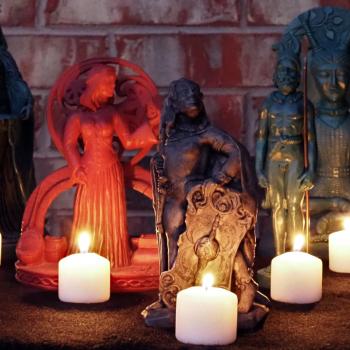Now Featured in the Patheos Book Club
Take the Flag: Following God's Signals in the Race of Your Life
by Rob Fuquay
You're in the driver's seat
I may be going out on a limb here, but if the apostle Paul were alive today, I think he'd be a big fan of car racing. Why do I say that? Because Paul had an obvious fascination with the racing of his day. In his first letter to the Corinthians, notice the way he illustrates the spiritual life: "Do you not know that in a race the runners all compete, but only one receives the prize? Run in such a way that you may win it" (9:24). He often spoke about the race of faith. And look at how he sums up his life in his letter to Timothy: "I have fought the good fight, I have finished the race, I have kept the faith" (2 Tim. 4:7).
There's no doubt Paul witnessed footraces, and obviously he saw a larger meaning in them. In this day and age, when life moves at breakneck speed, why wouldn't Paul be attracted to the thrill of car racing? I know I am and, like Paul, I can easily see symbolism in this modern-day sport. Auto racing can help us describe our lives.
One day we will cross a finish line. The engines will stop. But what are we racing for? The aim of this series is to help us think about that question.
I didn't start out as a car-racing fan. I was five years old, growing up in North Carolina, when I went to my first race with a friend whose dad was a big fan. All I remember of that experience was clamping my hands over my ears, trying to block out the roar of the engines, and then having a headache that lasted three days. Not exactly the way to make a kid fall in love with the sport.
Yet all that has changed since I've served churches in the two biggest auto-racing cities in America: Mooresville, North Carolina, and now Indianapolis, Indiana. Mooresville is about thirty miles north of Charlotte, which most people consider the home of the National Association for Stock Car Auto Racing—of course more popularly known as NASCAR. Yet Mooresville is where most of the NASCAR race teams locate their garages and offices, and many drivers live in the surrounding area of beautiful Lake Norman. A Mooresville water tower declares it's "Race City USA!"
During my time there I got to know drivers, team owners, and people involved with various aspects of racing, such as crew teams, mechanics, and suppliers of car and engine parts. I learned more about stock-car racing and began attending races. From Mooresville I moved to Indianapolis, which, of course, is known for one of the biggest racing events in the world, the Indy 500.
It's easy to tell the difference between IndyCars and stock cars. IndyCar features open-wheel racing; their wheels extend outside the car body. The wheels on stock cars are located under the fenders.
IndyCars go significantly faster than stock cars because of their light weight and low-to-the-ground design.
There's lighthearted jesting between fans of the two series. After I moved to Indianapolis, a new friend gave me a greeting card that depicted two guys in ball caps and overalls standing by a shiny automobile. Below it was the caption, "Ever wonder how NASCAR got its name?" Inside the card one fellow says to the other, "That's a nasss car. Yep, that's a real nas-car." I got a good chuckle out of my friend when I read it aloud with my own Southern drawl.
Over the years I've grown in my appreciation for car racing and all the traditions that go with it. One that especially intrigues me is the sport's use of flags to send signals to the drivers. It's amazing to think that, for all the sophisticated engineering that goes into today's cars, the racing world still sticks with this age-old form of communication. The use of flags in competition can be traced to bicycle racing in France in the 1860s, and they became a common sight when car racing was born in the 1890s.
Historians have tried unsuccessfully to trace the origins of racing's most famous flag, the checkered flag, but they speculate that perhaps someone improvised with a checkered tablecloth to signal the end of a race. Other flags eventually came along to send different messages to the drivers: start, yield, caution delay, disqualification, final lap. However, the use of flags began, they're obviously practical. Early racing, especially, was a dusty affair, so drivers could see the flags through the haze. Flags also speak boldly amid the deafening noise of the race.
It's no giant leap to garner greater understandings from this symbolic form of communication. God too is signaling to us amid the bustle and noise of our fast-paced lives. As I reflected on the racing flags, I began to see how their messages correspond to the important moments in our spiritual lives as God seeks our attention.
If you are a racing fan, I hope this series will give you a new appreciation for your race of faith. Even if you are not a race fan, I hope you find relevance in the meaning behind the symbolism.
I created the series not to make you into a racing fan but a greater follower of Jesus Christ, the author and perfecter of our faith. Just as God sends us signals, Jesus holds the key to the ignition of faith.
But that still puts you in the driver's seat. So buckle your seat belt, strap on your helmet, and in the words of NASCAR announcer and former driver Darrell Waltrip, "Boogity, boogity, boogity, let's go racing!"
11/1/2016 4:00:00 AM




